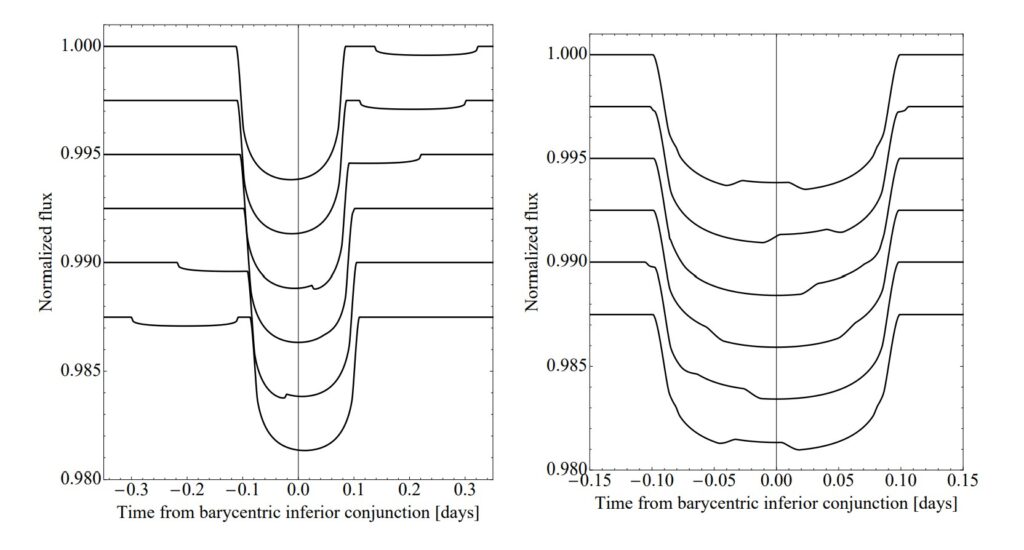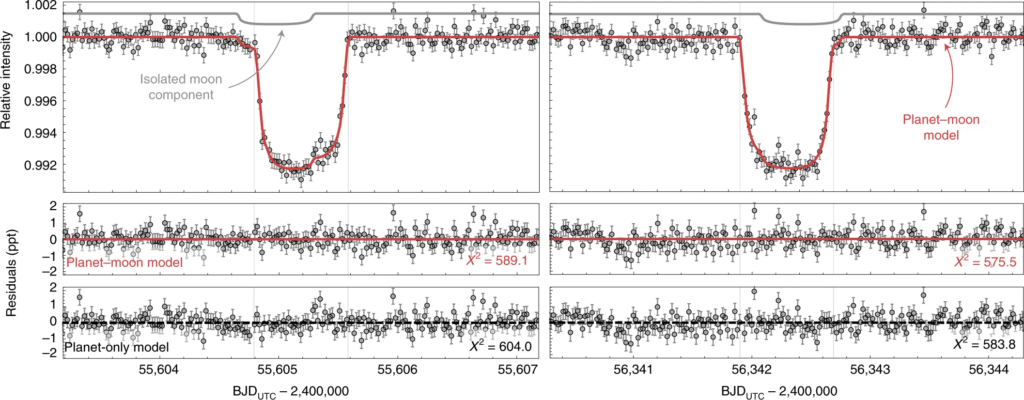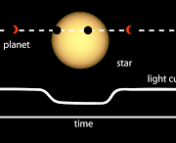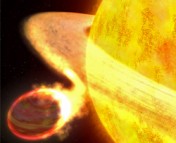Title: An exomoon survey of 70 cool giant exoplanets and the new candidate Kepler-1708 b-i
Authors: David Kipping, Steve Bryson, Chris Burke, Jessie Christiansen, Kevin Hardegree-Ullman, Billy Quarles, Brad Hansen, Judit Szulágyi & Alex Teacheyi Fors, Daniel del Ser, Evgenya L. Shkolnik, Carl Ziegler, Erin E. Goeke, Aaron D. Pietraallo, Joshua Haislip, Nicholas M. Law
First Author’s Institution: Department of Astronomy, Columbia University, New York, NY, USA
Status: Published in Nature Astronomy [open access]
Note: An excellent video summary of today’s paper is available here on the Cool Worlds YouTube channel, created by the lead author David Kipping.
An elusive class of planetary object
Given the abundance of moons in our Solar System, it is reasonable to presume that exomoons will reside around some exoplanets, which has motivated efforts to detect them. Transit photometry, where the presence (and other properties like radius) of a planet is inferred from observing the periodic dips in brightness of its host star, has also been one of the most promising strategies to look for exomoons. Figure 1 shows example transit curves of a planet-moon pair.

However, transit surveys are biased towards shorter period planets that orbit close to their stars. Sadly, moons of shorter period planets are less likely to survive due to the strong gravitational effects of the host star. Encouragingly, a small sample of long-period, Jupiter-like planets have also been detected by the Kepler space telescope! Since moons around long-period planets are most likely to be stable and survive, the transit photometry data of these planets are worth digging into for possible signs of an exomoon (or multiple exomoons!). A famous example of a contested exomoon candidate is around Kepler-1625 b, a gas-giant planet orbiting a sun-like star, where the posited exomoon signal, even when observed with the Hubble Space Telescope, is too weak to lead to a conclusive detection.
A first of its kind survey of exomoons
Aiming at finding more exomoon candidates orbiting wide-orbit planets, like Kepler-1625b, today’s authors analyzed the transit data of 70 Jupiter-like planets on wide orbits (such that their equilibrium temperature is < 300 K), as observed by the Kepler space telescope and filtered for sufficient quality. First, the authors subject these 70 planets to the following tests:
- a planet-moon model of transit should fit the transit data better than a planet-only model
- the transit curve should be consistent with a planet on a near-circular orbit (as high eccentricities diminish the suitability for moons)
- if data for more than two transits are available for the planet, then the object should exhibit transit timing variations or TTVs, which is indicative of another mass in the system, either a planet or an exomoon, gravitationally ‘tugging’ on the transiting planet and altering the exact time of its transit around the host star.
Eleven planets pass the authors’ trio of initial tests. Next, these eleven planetary transit curves are fitted with another planet-moon model, but this time parameters such as radius of the moon and bulk density of the planet or moon are allowed to have unphysical or unrealistic values (for example, a negative radius of moon). This allows the authors to fairly evaluate the preference of models with a non-zero moon mass, a non-zero moon radius and a positive moon radius. Only three candidates survive these additional checks. Upon further scrutiny of the transit curves of these three finalists, two of them are ruled out as the ‘exomoon’ signals in their transit curves could also be attributed to unaccounted background star, whose signal blended with that of our stars of interest, or star spots, which also cause the star’s brightness to change periodically, just like a transiting planetary body.
And the winner is…
Kepler-1708 b! This cool gas-giant planet is the only one that the authors find compelling evidence for the presence of an exomoon (Figure 2), dubbed as Kepler-1708 b-i. Further tests put the false positive probability of the exomoon signal in Kepler-1708b’s data at around 1%. Although they don’t find any compelling grounds yet to reject Kepler-1708 b-i, the authors urge caution and look forward to observations from the Hubble Space Telescope, the newly launched James Webb Space Telescope, or the upcoming PLATO mission to provide data precise enough to help us further scrutinize the existence of Kepler-1708 b-i.

Another surprising exomoon candidate
Kepler-1708 b-i, just like Kepler-1625 b-i, is an unexpectedly large exomoon candidate: a mini-Neptune moon (between 2-3 times Earth’s radius) orbiting at approximately 12 planetary radii around a Jupiter-sized planet, which itself orbits a Sun-like star at 1.6 AU (for comparison, our own Jupiter orbits our Sun at around 5 AU).
The authors also perform simulations of the orbital evolution of Kepler-1708 b-i, under the tidal forces of its host planet Kepler-1708 b, over the age of the host star Kepler-1708. These simulations show that starting from a compact orbit, the moon is expected to migrate outwards to close to where its current orbit around the planet is. While this fit wells with the current observations, it makes the formation scenario less clear, as several broad scenarios can produce the initial configuration of a moon in a compact orbit, such as planet-planet collisions, formation of moons within the gaseous disk around the planet, also called circumplanetary disk (for example the Galilean moons) or direct capture (for example Phobos and Deimos, the moons of Mars, could possibly be captured asteroids).
While the existence of moons on wide orbits, like Kepler-1708 b-i and Kepler-1625 b-i, challenge conventional thinking of planetary formation, further observations can help us better understand their properties and provide an exciting opportunity to investigate unconventional but plausible formation scenarios.
Astrobite edited by Wei Vivyan Yan
Featured image credit: Helena Valenzuela Widerström




